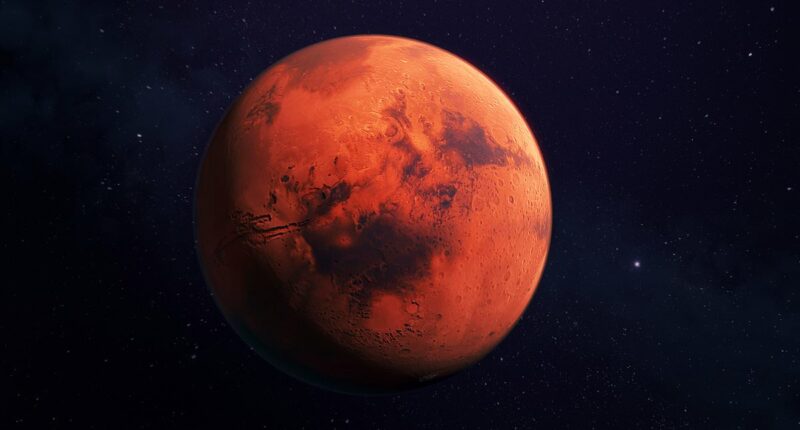Share this @internewscast.com
NASA has announced the discovery of what it believes to be ancient microbial life on the Martian surface.
Sean Duffy, the new head of the space agency, announced that a sample obtained by the Perseverance rover has been identified as the ‘clearest sign of life’ yet discovered on Mars.
During a news briefing on Wednesday, NASA’s Associate Administrator Nick Fox said: ‘These are exactly the kinds of signs we would expect from something biological.’
Researchers have been examining strange spots and seed-like forms in ancient Martian rocks that could indicate the presence of microscopic life forms in the distant past.
These formations, called ‘poppy seeds’ and ‘leopard spots,’ were discovered in mud-like rocks in Neretva Vallis, within the Jezero Crater where a river existed billions of years ago.
The rover has been exploring this region since landing on Mars in 2021.
Scientist Joel Hurowitz revealed how these tiny signatures found in the crater pointed to the existence of life on Mars billions of years ago.
The rover’s instruments detected elements such as iron and phosphorus in these formations, which can develop when microorganisms decompose organic matter, a potential sign of life on Earth.

NASA officials revealed new findings by the Perseverance rover, which has been exploring Mars (pictured) since 2021

NASA Administrator Sean Duffy revealed that a sample collected by Perseverance is the ‘clearest sign of life’ on Mars
For years, the rover has been transmitting images back to Earth, showing crystalline remnants from ancient water flow and a reddish area containing organic compounds and a potential energy source for microbial life.
Perseverance collected the life-proving rocks on July 21, 2024 while exploring the northern edge of Neretva Vallis, the ancient river valley formed roughly 3.7 billion years ago.
Scientists noticed the vein-like structures throughout, finding they were white calcium sulfate.
The crystalline solids on the Martian surface are hard-water deposits left behind by ancient groundwater flowing through the now dusty landscape.
Between those veins were bands of material with a reddish color suggesting the presence of hematite, one of the minerals that gives Mars its distinctive rusty hue.
Duffy noted that the announcement Wednesday was the culmination of 30 years of research on the Red Planet.
He added that the latest findings went through a peer-review process that proved the samples likely had a biological origin.
‘We are here to say this is exciting and we want to share that news. This could be very real,’ Duffy continued.

In 2024, Perseverance spotted a vein-filled arrowhead-shaped rock that featured chemical signatures and structures likely formed by microbial life billions of years ago

Perseverance took a selfie in the Jezero Crater on Mars when it found the biological samples
When asked if NASA plans to retrieve the potential organic samples from Mars, Duffy said the space agency was still looking at how and when they could get the rocks back to Earth, adding that ‘we’re going to look at our budgets.’
The new administrator appointed by President Trump noted that ‘the president loves space’ and believed NASA has the money to complete its mission, which is now focused on manned missions to space.
Duffy noted the space agency’s mission was going to be ‘a little more focused’ but felt comfortable asking the White House for more funding if it was needed to confirm the findings on Mars.
‘At no point has this administration said “we don’t care about samples,”‘ Fox added while addressing question about NASA’s changing priorities regarding Mars exploration.
Previously, the Trump Administration had cut the Mars sample retrieval mission from its budget proposal for NASA.
It was part of $6 billion that had been slashed from NASA’s future budget in the May proposal to Congress, even though the ongoing sample study had already cost billions.
Duffy said that NASA was now looking at a faster and more cost-effective way of getting the Perseverance’s samples back for examination.
As for NASA’s upcoming space missions, Duffy revealed that four astronauts will circle the moon ‘early next year’ as part of the Artemis II lunar mission.





